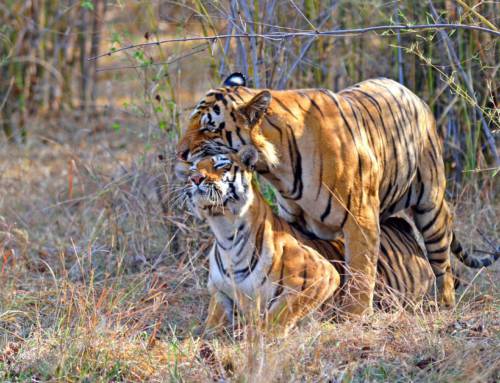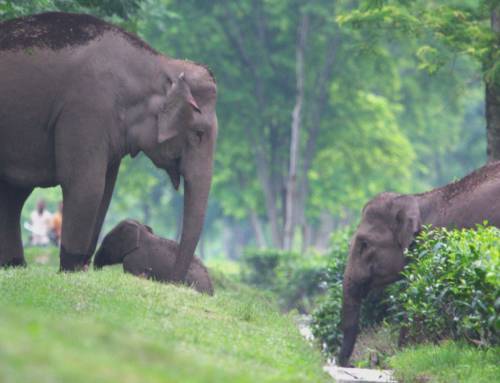Research Article: Madsen, Emily & Ray, Shreya & Petracca, Lisanne & Kamler, Jan. (2025). The Potential for Subordinate Predator Release in Terrestrial Mammalian Carnivore Assemblages. Mammal Review. 10.1111/mam.70003.
Blog Author: Deep Gogoi
Key Takeaways:
- When a top predator decreases in number, smaller predators (mesopredators) increase and change how the ecosystem functions.
-
- Most studies show a link between top predator loss and smaller predator rise, but clear proof is hard to find.
- Research mostly focuses on wolves, foxes, and coyotes, while big cats like tigers and leopards get less attention, shaping our understanding of predator behavior.
- Predator rankings aren’t always simple—big predators don’t always dominate, and sometimes smaller ones influence them.
- Scientists argue that conservation efforts should rely on local research instead of assumptions since predator interactions differ across ecosystems and need long-term studies for a clearer understanding.
In the wild, predators play a crucial role in maintaining balance within ecosystems. Hence the question arises, what happens when the top predator disappears? The answer lies in a fascinating ecological phenomenon called subordinate predator release, where the decline of a top predator allows smaller predators to thrive, disrupting the natural balance of the ecosystem. Originally proposed by ecologist Michael Soulé and his team in 1988, this idea has been widely studied, however, it remains complex and sometimes controversial.
Predator release is important for the success of conservation efforts. If scientists fail to identify the effects of predator release, it could lead to poor decisions, such as failing to anticipate ripple effects in ecosystems or underestimating the risk of species extinctions. However, linear relationships that one predator’s decline directly causes another’s rise are difficult. Many studies show correlations, but true causation is harder to establish.
A large review by researcher Jachowski et al. found mixed evidence for mesopredator release—where smaller predators, like foxes and coyotes, increase when top predators decline. Most studies focus on canids (wolves, foxes, and coyotes), while big cats such as tigers and leopards are less studied. Since canids are more adaptable to changing environments, this research gap may shape how scientists understand predator interactions. A later study by Van Schaik and his team explored this pattern in Europe, and the current review by Emily Madsen attempts to examine it globally using a simpler approach.
They conducted an extensive meta-analysis, by analyzing findings from several studies across the globe. They searched for scientific papers on subordinate predator release using major databases like Scopus, Google Scholar, and Web of Science. Then the results are filtered to include studies that monitored at least two carnivore species interacting in the wild, showed one predator potentially suppressing another, and included clear spatial or temporal data. After reviewing over 5,200 studies, only 176 met the criteria for inclusion. Most research came from North America (38%), followed by Africa (18%) and Europe (14%). The USA, South Africa, India, and Australia were among the most studied regions.
Scientists used different methods to track predator interactions, including camera traps (45%), radio collars (15%), and footprint surveys (12%). They ranked studies based on the strength of their evidence: 51% showed weak evidence, comparing species at different locations; 28% showed moderate evidence, including population trends over time; and 20% showed strong evidence, demonstrating consistent, long-term suppression of one species by another.
Interestingly, both canids and felids appeared frequently as dominant predators. However, canids were more often the suppressed species, indicating they tend to experience release more frequently. The most common interactions involved coyotes suppressing red foxes, lions suppressing leopards, and wolves suppressing coyotes. One surprising finding was that large predators do not always suppress smaller ones. While large predators often limit medium-sized predators, some studies found cases where smaller predators influenced larger ones. This challenges traditional thinking about predator hierarchies and suggests a need for more detailed research.
These findings highlight the complexity of predator interactions and the need for careful conservation planning. Conservationists must avoid extrapolating their findings across ecosystems, as a dominant predator’s disappearance does not always lead to mesopredator release. Predator dynamics vary across ecosystems and findings should not be generalized across ecosystems. Reconciling these seemingly opposite conclusions can help clarify the bigger picture. Future research should focus on strengthening causal evidence, using long-term studies to track predator populations over time. Conservationists should also analyze the strength of interactions between predator species to better predict ecosystem changes.
By continuing to study these hidden battles among predators, scientists can gain deeper insights into the delicate balance of nature, and how to protect it for future generations.
To access the original article, click here!
Keywords: Subordinate Predator Release, Mesopredator Dynamics, Predator Suppression, Ecosystem Balance




